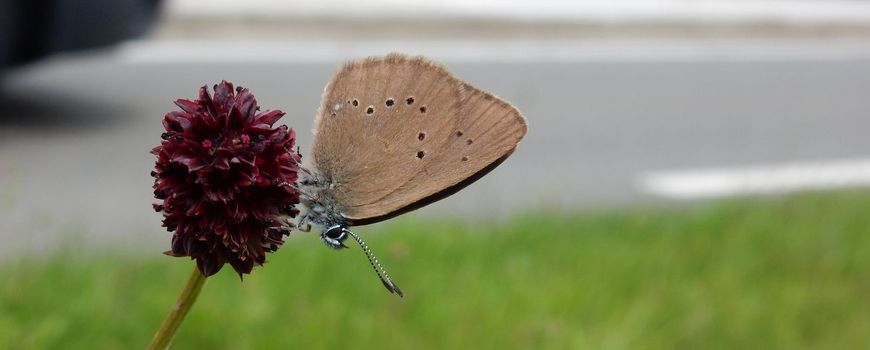There were hardly any large pimpernel plants left for the females to lay their eggs on. There was hope that this would only be a blow to the population and would not lead to the disappearance of the butterfly.
From that moment on, volunteers from the Butterfly Foundation searched for the butterfly very regularly, almost daily. In total, only five butterflies were observed in 2023. In the summer of 2024, not a single dark pimpernel blue was seen. The butterfly species seems most likely to have disappeared from our country. The Butterfly Foundation does not accept this. In collaboration with the province of Limburg and the Limburgs Landschap, further work is being done to realize a suitable habitat. As soon as that is there, the butterfly can be released again.
Unique way of life
The dark pimpernel blue is a real farmland butterfly, which loves flowery meadows. The butterfly is quite picky and has a very special way of life. The females lay eggs on the flower bud of the large pimpernel, where the caterpillar stays for some time. Then it leaves the plant and goes to the ground, where it hopes to be found and adopted by the workers of the common stinging ant. They take the caterpillar to the ant nest, where it stays for the winter and lives as a parasite on the ant larvae. After it has pupated, the butterfly emerges from the ant nest at the end of June.
Not only is its way of life special, this butterfly also enjoys a special protection status. It is listed in the Habitats Directivewhich protects both the species and the habitat throughout Europe. The development of new species-rich habitat, which also benefits many other endangered plant and animal species, is therefore continued.
Colorful habitat
Colourful hay meadows in the Roer valley and in the Vlootbeek valley – with large pimpernel, knotweed, bird’s-foot trefoil, wild carrot and wild bertram – will be further developed and expanded. At the same time, a suitable source population of butterflies must be found for a reintroduction in the future. The genetic variation of the butterflies is being investigated in large populations in Germany. Populations that have lost many characteristics due to inbreeding may not be able to adapt to the situation in the Netherlands and will be eliminated. The ants also deserve attention. They must be suitable as hosts, so that the caterpillars are adopted by them and can grow into butterflies.
In the future habitat it is important to develop places with a large variety of microclimates. For insects a sunny spot is sometimes useful to warm up and be active. However, it can also get too hot, so they prefer to stay in the shade. The soil must be suitable for the ants to make their nests in and not dry out too quickly. A landscape with bushes, shrubs and hedges and a high groundwater level can provide this. In this rich landscape the dark pimpernel blue can eventually be brought back. The chances of staying permanently in the Netherlands will then be greater.
Text: Irma Wynhoff, The Butterfly Foundation
Photos: Kars Veling, The Butterfly Foundation
